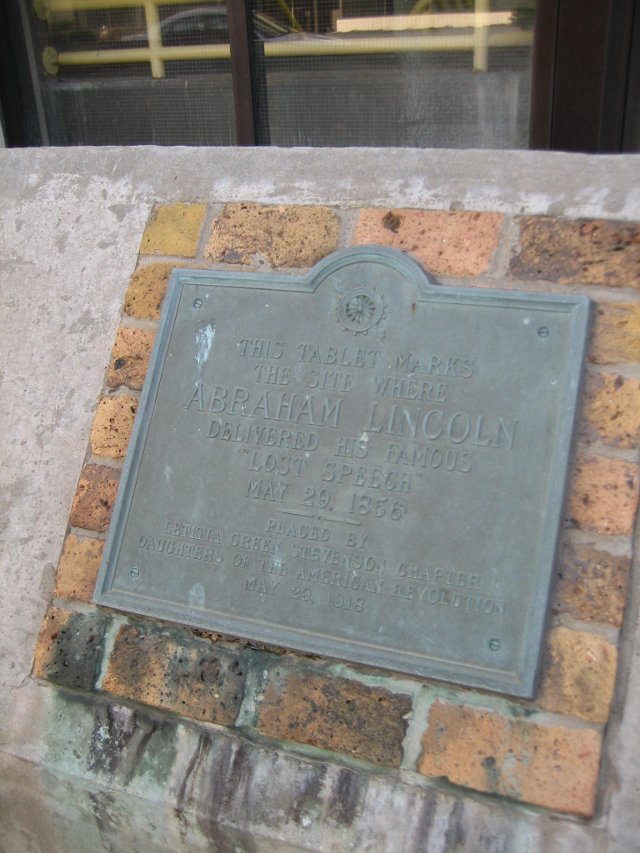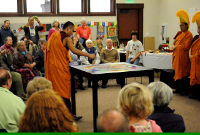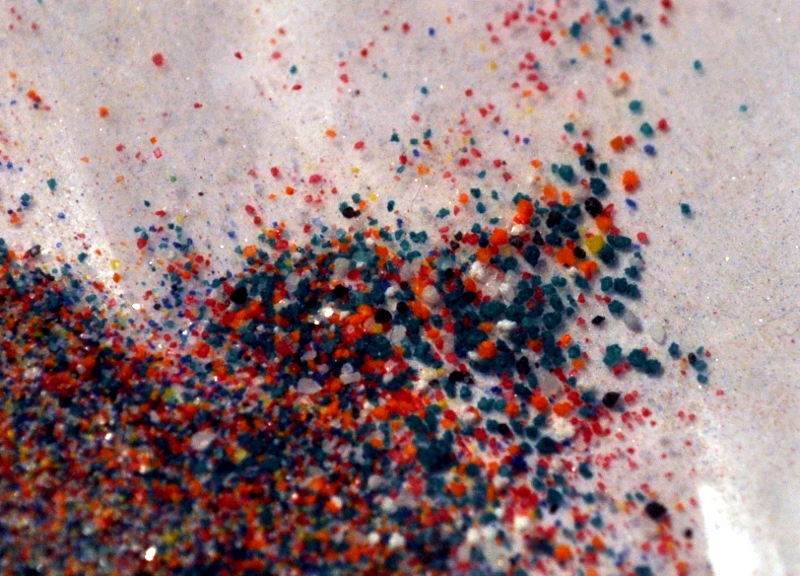The Plaque
Just down the block from Rosie’s Pub in Bloomington Illinois, on the southwest corner of Front and East streets, there now stands a dull, grey, nondescript concrete parking structure. At the foot of this structure is a low horizontal set of equally bland concrete blocks set in a row, next to a concrete bench whose sole purpose is apparently to provide a place for weary pedestrians to sit and admire the “One Way” sign posted on the corner.
 Next to the bench and out of view of those weary pedestrians is a tarnished brass plaque, set in limestone brick and mounted on one of the concrete blocks. It has clearly seen better years — 90 of them to be precise — the sole survivor of more than one building that has risen and fallen at that same corner on that same street, in that same town. And the plaque will most likely still stand at that spot 90 years from now, when the parking structure will likewise be torn down to be replaced with something else equally fresh, new and imminently forgettable. On the plaque is written the following words:
Next to the bench and out of view of those weary pedestrians is a tarnished brass plaque, set in limestone brick and mounted on one of the concrete blocks. It has clearly seen better years — 90 of them to be precise — the sole survivor of more than one building that has risen and fallen at that same corner on that same street, in that same town. And the plaque will most likely still stand at that spot 90 years from now, when the parking structure will likewise be torn down to be replaced with something else equally fresh, new and imminently forgettable. On the plaque is written the following words:
This tablet marks the site where
ABRAHAM LINCOLN
delivered his famous
“Lost Speech”
May 29, 1856
Abraham Lincoln gave many great speeches in his time, some of great passion and transcendent language. The Emancipation Proclamation, the Gettysburg Address, and others equally well known and capitalized, are filled with phrases that have become iconic. Though often spoken extemporaneously, the speeches were all duly written down and recorded by reporters and others present at these events, and published countless times. With that in mind, then, consider then the following two facts
- The fiery speech Lincoln gave at this spot at the state Republican convention in Bloomington in 1856 was said by many present to be the greatest speech Lincoln ever gave or ever will give, and not only set the course for the fledgling national Republican party over the next century, but placed the little-known senator from Illinois on the track to the Presidency.
- Nobody alive today knows what on earth it was that he said.
I find those two facts, taken together, to be absolutely startling — only to be outdone by the even more startling fact that I’ve managed to reach the age of 52, never having heard this story before. Indeed, if more intriguing stories like this had been told when I was a kid, I might have taken a stronger interest in my History studies. It is a great mystery and an enigma which we will never solve. And in some ways, I kind of like it like that. But in others, I really wish I knew what it was that he said.
The Background
In her book “Team of Rivals”, this historian Doris Kearns Goodwin describes the events of the previous weeks and months that led up to this speech. Debate had been raging for some time over the Dred Scott decision, in which the Supreme Court, led by chief justice Roger B. Taney, had decreed that the black man “had no rights which the white man was bound to respect”. More recently, the issue of whether the new western states of Nebraska and Kansas should be allowed to legalize the practice of slavery divided the old Whig party and ultimately led to its dissolution.
Very much like today, the political climate and quality of dialog over the issues had become dysfunctional at best, and caustically toxic at worst. Talk of secession had already begun in the South. There were many hot topics at the time, but the big issue was slavery, its continuation in the south and possible extension into the new states out west. Just one week before the Illinois convention, the atmosphere surrounding the debate had become so poisonous that South Carolina congressman Preston Brooks walked up to senator Charles Sumner with a heavy cane and savagely beat the senator until he was bloody and unconscious. Though the senator survived and was able to return after three years of recuperation, the news of the event radicalized both sides of the already polarizing issue.
The Speech
And so it was in this climate that Abraham Lincoln walked up to the stage on May 29, 1856 to deliver a speech to the Illinois Republican convention, which at the time was a motley crew of disaffected folks of many political stripes, “old-line Whigs, bolting Democrats, Free-Soilers, Know Nothings, and abolitionists.” By all reports, Lincoln’s speech was raw, fiery, and full of wrath and righteous indignation. Lincoln, who up to that time had watched his words carefully, had at last had enough, and in this speech, the gloves had come off and he spoke his mind, and used his now finely honed skill at extemporaneous wordcraft to its highest application.
The speech lasted for several hours, and grew in intensity, interrupted every few minutes by louder and louder shouts and applause and stamping of feet. According to Goodwin’s book, “So enthralled were those in the audience that the reporters cast aside their pens so as to concentrate on what Lincoln said, and the unrecorded speech has become known to history as the famous ‘Lost Speech.'” Those who had entered the hall as an unorganized collection of angry and upset individuals from various walks of life, emerged by the end of the evening an energized and united force: the first members of what became the national Republican party, which would see Abraham Lincoln elected as the 16th president.
And to this day, that is all that we know about this speech.
Over the years that followed there were a number of claims and attempts by people who attended that speech to reconstruct what Lincoln said from memory, or to point out other speeches of Lincoln’s that borrowed bits from this seminal speech. But after publication, none of these reconstructions were approved and validated by others who were there. More recently, some historians have conjectured that the text of the speech was so incendiary that it was intentionally suppressed, in fear of even further dividing the country. That such a conspiracy of many hundreds of individuals over such a long period of time could be maintained challenges credulity.
What Lincoln Said
One thing that we do know about the core of Lincoln’s philosophy was that it can be paraphrased like this: Opinions of justices of the supreme court notwithstanding, the work of the founders of this country was not finished when they wrote the Constitution: that document is just the start of a work-in-progress, driven by its creator’s vision. And that vision can be best expressed, not by the Constitution itself, but by the preamble to the Declaration of Independence, which contains the phrase:
We hold these truths to be self-evident, that all men are created equal, that they are endowed by their Creator with certain unalienable Rights, that among these are Life, Liberty and the pursuit of Happiness. That to secure these rights, Governments are instituted among Men, deriving their just powers from the consent of the governed[…]
Doris Goodwin in her book and others elsewhere have written about Lincoln’s desire to put these words of the Declaration of Independence into codified law and practice. Goodwin quotes Lincoln in a letter to Joshua Speed:
“How can any one who abhors the oppression of negroes, be in favor or degrading classes of white people? Our progress in degeneracy appears to me to be pretty rapid. As a nation, we began by declaring that “all men are created equal.” We now practically read it “all men are created equal, except negroes.“
and regarding the recent activities of the “Know Nothing” anti-immigration party, he continued:
“When the Know-Nothings get control, it will read “all men are created equal, except negroes, and foreigners, and Catholics.“
(were Lincoln writing today, he would have no doubt also added “…and gays and muslims“).
Lincoln took at its word the Ninth amendment of the Constitution, which stated that the “rights” enumerated by the Constitution should not be considered exhaustive, but that there are other rights that are possessed and retained by the people. These other rights, Lincoln knew, are those unalienable rights which were not “created” by a government and bestowed upon a person, but are those natural rights which all men, all human beings possess by nature of being men, and which can never be taken from them.
The existence of natural rights is not mentioned anywhere in the Constitution. Lincoln believed that this was a great flaw in the document, and his life’s work was to bring the laws of the states and country more in line with the idea of the universal rights of man, regardless of color, religion, or even citizenship. This was also the life’s work of Dr. Martin Luther Kind Jr, who also quoted the Declaration of Independence, and whose realization remains to this day a work largely unfinished.
Why This Matters
All that we know for sure is what Lincoln had been saying over and over, in the years leading up to that speech, and what he said after. And that makes The Lost Speech all the more tantalizing, because knowing that up to this point he was speaking to the general public, and afterwards was delivering campaign speeches, only on this one occasion was he speaking his innermost thoughts and heart and mind to truly kindred spirits, without censorship or hesitation.
It seems that there is something in a man that when the moment finally comes to speak their true mind, and all guards have come down, the words take on a weight and a glow of authenticity that pulls you in, because at some level you know that you are witness to one of those singularly rare moments to see, for just a moment, the raw power and depth of passion that is possible within one man’s soul. That is what I think made the reporters and all others present drop their pencils and listen: because the voice and the moment demanded it.
 We had heard that Tibetan Buddhist monks were up in Springdale this past week, and were constructing a traditional Tibetan mandala sand painting. On Saturday November 20 we drove up to watch the monks put their finishing touches on the elaborate and delicate mandala. The purpose of this ceremony is to emphasize the transient nature of life and all phenomena. The mandala that the monks constructed here in Springdale was a representation of the bodhisattva Avalokiteshvara, who embodies Buddhist principle of Compassion, and is also regarded as the patron deity of Tibet. This picture (above) is the best photo I was able to take of their final work, and it still does not capture the lush color and beauty of the painting that sat on the table before us.
We had heard that Tibetan Buddhist monks were up in Springdale this past week, and were constructing a traditional Tibetan mandala sand painting. On Saturday November 20 we drove up to watch the monks put their finishing touches on the elaborate and delicate mandala. The purpose of this ceremony is to emphasize the transient nature of life and all phenomena. The mandala that the monks constructed here in Springdale was a representation of the bodhisattva Avalokiteshvara, who embodies Buddhist principle of Compassion, and is also regarded as the patron deity of Tibet. This picture (above) is the best photo I was able to take of their final work, and it still does not capture the lush color and beauty of the painting that sat on the table before us. When we arrived at the Canyon Community Center the monks were in the final stages of the project, under the watchful gaze of a photo of the Dalai Lama in a small altar on the stage. The large hall was filled with the sound of monks chanting and throat-singing as they concentrated on the task of dropping individual grains of sand onto the painting. The instrument that they used to do this was a thin hollow metal tube called a chak-pur, which had a sort of washboard edge that the monks would scrape rapidly with a stick.
When we arrived at the Canyon Community Center the monks were in the final stages of the project, under the watchful gaze of a photo of the Dalai Lama in a small altar on the stage. The large hall was filled with the sound of monks chanting and throat-singing as they concentrated on the task of dropping individual grains of sand onto the painting. The instrument that they used to do this was a thin hollow metal tube called a chak-pur, which had a sort of washboard edge that the monks would scrape rapidly with a stick. ![]() This produced an intriguing almost musical sound, though its main purpose was to cause the sand to flow out of the end of the tube and onto the painting. In this recording you can hear the chanting of the monks and the scraping of the sticks on the washboard surface of the tubes; I like that the incidental sounds of children talking is mixed in, with the rumble of conversation. The esoteric and the divine, integrated seamlessly with everyday life. There is no difference between the two, they seemed to say, and it did not matter who you were — even the fundamentalist Mormon women, in their robin’s egg blue prairie dresses, came to watch and admire the work of these Buddhist monks.
This produced an intriguing almost musical sound, though its main purpose was to cause the sand to flow out of the end of the tube and onto the painting. In this recording you can hear the chanting of the monks and the scraping of the sticks on the washboard surface of the tubes; I like that the incidental sounds of children talking is mixed in, with the rumble of conversation. The esoteric and the divine, integrated seamlessly with everyday life. There is no difference between the two, they seemed to say, and it did not matter who you were — even the fundamentalist Mormon women, in their robin’s egg blue prairie dresses, came to watch and admire the work of these Buddhist monks. After the monks had completed the mandala, they allowed the public to observe the painting for one hour before they destroyed it with a brush, gathering all the colored sand into a dull gray pile. Half of the sand was placed into small plastic bags for those observers who wanted them, and the rest was poured into the Virgin river. We took a small bag of the sand home with us.
After the monks had completed the mandala, they allowed the public to observe the painting for one hour before they destroyed it with a brush, gathering all the colored sand into a dull gray pile. Half of the sand was placed into small plastic bags for those observers who wanted them, and the rest was poured into the Virgin river. We took a small bag of the sand home with us. Though from a distance the blended sand appears gray, on close inspection you can still see the individual colors of each grain that went into the painting. By my estimate the average grains are a few thousandths of an inch in diameter, and so the number of grains in the entire painting must have been somewhere around a hundred billion, or roughly the same as the number of stars in the galaxy. It would take a very long time to try to sort these grains back out into the original colors and reconstruct a similar painting, and of course you shouldn’t try.
Though from a distance the blended sand appears gray, on close inspection you can still see the individual colors of each grain that went into the painting. By my estimate the average grains are a few thousandths of an inch in diameter, and so the number of grains in the entire painting must have been somewhere around a hundred billion, or roughly the same as the number of stars in the galaxy. It would take a very long time to try to sort these grains back out into the original colors and reconstruct a similar painting, and of course you shouldn’t try.